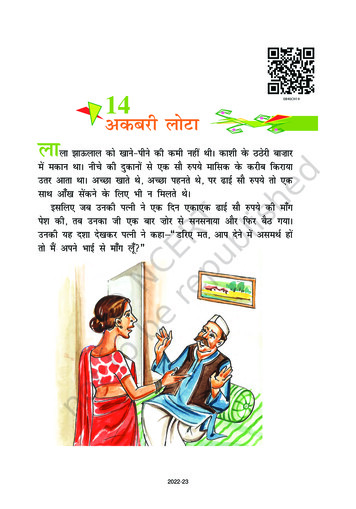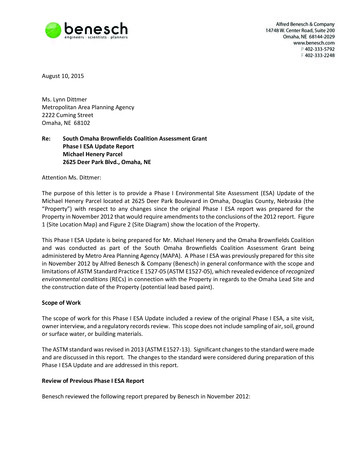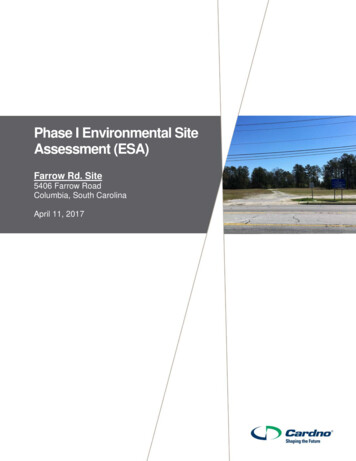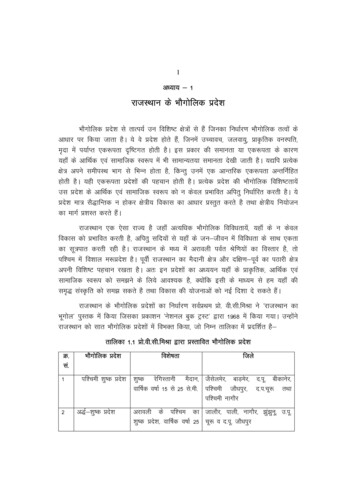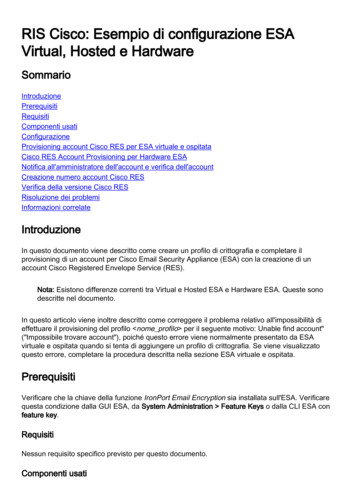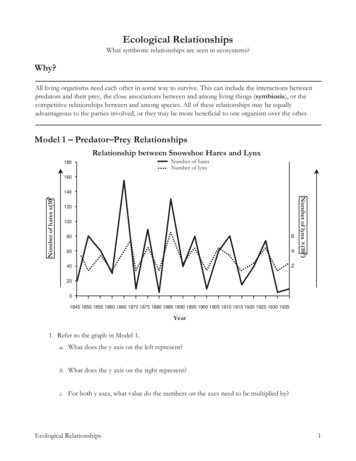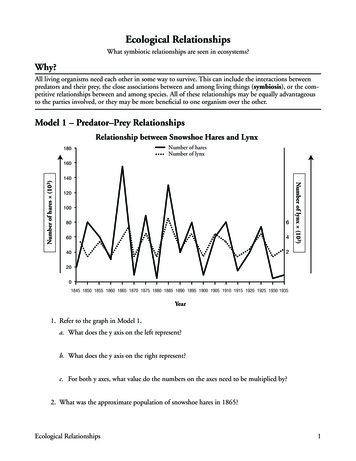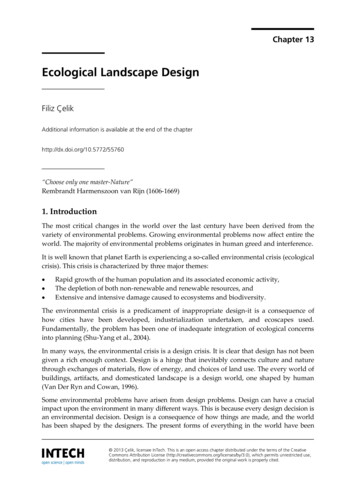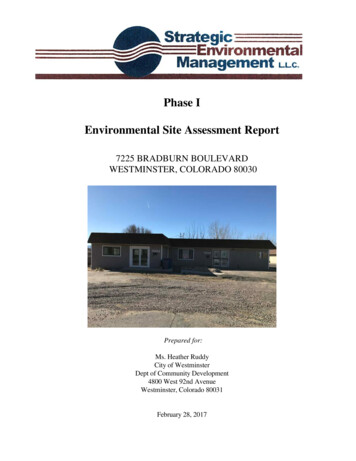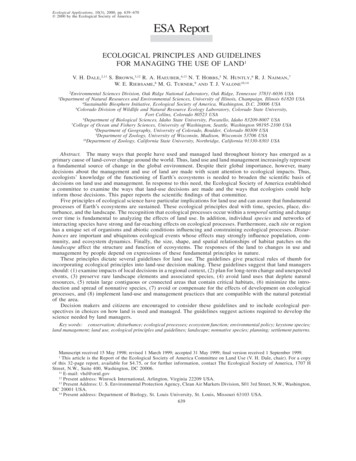
Transcription
Ecological Applications, 10(3), 2000, pp. 639–670䉷 2000 by the Ecological Society of AmericaESA ReportECOLOGICAL PRINCIPLES AND GUIDELINESFOR MANAGING THE USE OF LAND1V. H. DALE,2,11 S. BROWN,3,12 R. A. HAEUBER,4,13 N. T. HOBBS,5 N. HUNTLY,6 R. J. NAIMAN,7W. E. RIEBSAME,8 M. G. TURNER,9 AND T. J. VALONE10,142Environmental Sciences Division, Oak Ridge National Laboratory, Oak Ridge, Tennessee 37831-6036 USADepartment of Natural Resources and Environmental Sciences, University of Illinois, Champaign, Illinois 61820 USA4Sustainable Biosphere Initiative, Ecological Society of America, Washington, D.C. 20006 USA5Colorado Division of Wildlife and Natural Resource Ecology Laboratory, Colorado State University,Fort Collins, Colorado 80523 USA6Department of Biological Sciences, Idaho State University, Pocatello, Idaho 83209-8007 USA7College of Ocean and Fishery Sciences, University of Washington, Seattle, Washington 98195-2100 USA8Department of Geography, University of Colorado, Boulder, Colorado 80309 USA9Department of Zoology, University of Wisconsin, Madison, Wisconsin 53706 USA10Department of Zoology, California State University, Northridge, California 91330-8303 USA3Abstract. The many ways that people have used and managed land throughout history has emerged as aprimary cause of land-cover change around the world. Thus, land use and land management increasingly representa fundamental source of change in the global environment. Despite their global importance, however, manydecisions about the management and use of land are made with scant attention to ecological impacts. Thus,ecologists’ knowledge of the functioning of Earth’s ecosystems is needed to broaden the scientific basis ofdecisions on land use and management. In response to this need, the Ecological Society of America establisheda committee to examine the ways that land-use decisions are made and the ways that ecologists could helpinform those decisions. This paper reports the scientific findings of that committee.Five principles of ecological science have particular implications for land use and can assure that fundamentalprocesses of Earth’s ecosystems are sustained. These ecological principles deal with time, species, place, disturbance, and the landscape. The recognition that ecological processes occur within a temporal setting and changeover time is fundamental to analyzing the effects of land use. In addition, individual species and networks ofinteracting species have strong and far-reaching effects on ecological processes. Furthermore, each site or regionhas a unique set of organisms and abiotic conditions influencing and constraining ecological processes. Disturbances are important and ubiquitous ecological events whose effects may strongly influence population, community, and ecosystem dynamics. Finally, the size, shape, and spatial relationships of habitat patches on thelandscape affect the structure and function of ecosystems. The responses of the land to changes in use andmanagement by people depend on expressions of these fundamental principles in nature.These principles dictate several guidelines for land use. The guidelines give practical rules of thumb forincorporating ecological principles into land-use decision making. These guidelines suggest that land managersshould: (1) examine impacts of local decisions in a regional context, (2) plan for long-term change and unexpectedevents, (3) preserve rare landscape elements and associated species, (4) avoid land uses that deplete naturalresources, (5) retain large contiguous or connected areas that contain critical habitats, (6) minimize the introduction and spread of nonnative species, (7) avoid or compensate for the effects of development on ecologicalprocesses, and (8) implement land-use and management practices that are compatible with the natural potentialof the area.Decision makers and citizens are encouraged to consider these guidelines and to include ecological perspectives in choices on how land is used and managed. The guidelines suggest actions required to develop thescience needed by land managers.Key words: conservation; disturbance; ecological processes; ecosystem function; environmental policy; keystone species;land management; land use, ecological principles and guidelines; landscape; nonnative species; planning; settlement patterns.Manuscript received 15 May 1998; revised 1 March 1999; accepted 31 May 1999; final version received 1 September 1999.This article is the Report of the Ecological Society of America Committee on Land Use (V. H. Dale, chair). For a copyof this 32-page report, available for 4.75, or for further information, contact The Ecological Society of America, 1707 HStreet, N.W., Suite 400, Washington, DC 20006.11 E-mail: vhd@ornl.gov12 Present address: Winrock International, Arlington, Virginia 22209 USA.13 Present Address: U. S. Environmental Protection Agency, Clean Air Markets Division, S01 3rd Street, N.W., Washington,DC 20001 USA.14 Present address: Department of Biology, St. Louis University, St. Louis, Missouri 63103 USA.6391
ESA REPORT640INTRODUCTIONWake, now, my vision of ministry clear; Brighten mypathway with radiance here; Mingle my calling withall who will share; Work toward a planet transformed by our care.T. J. M. Mikelson, 1936The words of the Irish hymn by Mikelson have beenapplied literally to the earth. During the past few millennia, humans have emerged as the major force ofchange around the globe. The large environmentalchanges wrought by our actions include modificationof the global climate system, reduction in stratosphericozone, alteration of Earth’s biogeochemical cycles,changes in the distribution and abundance of biologicalresources, and decreasing water quality (Meyer andTurner 1994, IPCC 1996, Vitousek et al. 1997, Mahlman 1997). However, one of the most pervasive aspectsof human-induced change involves the widespreadtransformation of land through efforts to provide food,shelter, and products for our use. Land transformationis perhaps the most profound result of human actionsbecause it affects so many of the planet’s physical andbiological systems (Kates et al. 1990). In fact, landuse changes directly impact the ability of Earth to continue providing the goods and services upon whichhumans depend.Unfortunately, potential ecological consequences arenot always considered in making decisions regardingland use. Moreover, the unique perspective and bodyof knowledge offered by ecological science rarely arebrought to bear in decision-making processes on private lands. The purpose of this paper is to take animportant step toward remedying this situation by identifying principles of ecological science that are relevantto land-use decisions and by proposing a set of guidelines for land-use decision making based on these principles (Fig. 1). This paper fulfills this purpose throughfour steps. (1) It describes the conceptual and institutional foundations of land-use decision making, outlining the implementation of U.S. land-use decisions.(2) It identifies (a) ecological principles that are criticalto sustaining the structure and function of ecosystemsin the face of rapid land-use change and (b) the implications of these principles for land-use decisionmaking. (3) It offers guidelines for using these principles in making decisions regarding land-use change.Finally, (4) it examines key factors and uncertaintiesin future patterns of land-use change. Throughout, thepaper offers specific examples to illustrate decisionmaking processes, relevant ecological principles, andguidelines for making choices about land use at spatialscales ranging from the individual site to the landscape.The paper focuses on the United States, which somemay see as parochial; however, the incredible varietyEcological ApplicationsVol. 10, No. 3of political, economic, social, and cultural institutionsencountered throughout the world make a thoroughcomparative study impossible in a single paper. Moreimportantly, while the paper concentrates on land-usedecisions in the United States, the principles and guidelines it describes are applicable worldwide.In undertaking this paper, the Land Use Committeeof the Ecological Society of America (ESA) continuesan ongoing effort by the Society to marshal the resources and knowledge of the ecological-science community in understanding and resolving critical environmental-policy and resource-management issues. In1991, for example, the Sustainable Biosphere Initiative(Lubchenco et al. 1991) established the priority research areas that must be explored if ecologists are tocontribute in maintaining Earth’s life-support systems.Similarly, the ESA Report on the Scientific Basis ofEcosystem Management (Christensen et al. 1996) focused on the application of ecological science in managing ecological systems for extractive uses. Our reportcontinues that tradition, offering relevant ecologicalprinciples for making decisions regarding human actions that change the land from one category of use toanother (e.g., from forests to agriculture or from agriculture to housing subdivisions).Trends and patterns of land-use changeChanges in the cover, use, and management of theland have occurred throughout history in most parts ofthe world as population has changed and human civilizations have risen and fallen (e.g., Perlin 1989, Turneret al. 1990). Over the centuries two important trendsare evident: the total land area dedicated to human uses(e.g., settlement, agriculture, forestry, and mining) hasgrown dramatically, and increasing production ofgoods and services has intensified both use and controlof the land (Richards 1990). At the end of the 20thcentury, much of Earth’s habitable surface is dedicatedto human use, mostly for production of food and fiber.Some is used for conservation, but even that area ismapped, zoned, and controlled.Forests and grasslands, in particular, have undergonelarge changes (Houghton 1995). These changes haveoccurred at different times in various parts of the world.It is estimated that, between 1700 and 1980, the areaof forests and woodlands decreased globally by 19%and grasslands and pastures diminished by 8% whileworld croplands increased by 466% (Richards 1990).Furthermore, the pace of change has accelerated, withgreater loss of forests and grasslands during the 30 yrfrom 1950 to 1980 than in the 150 yr between 1700and 1850. Global croplands increased more since WorldWar II than in the entire 19th and early 20th centuries.Many centuries ago, intensive use of European forestsproduced construction materials, fuelwood, and agri-
June 2000PRINCIPLES AND GUIDELINES FOR LAND USE641FIG. 1. A roadmap to this paper shows that ecological principles relating to land use are developed into guidelines forland managers. These guidelines can inform land-use decisions so that land uses in the future benefit from ecologicalknowledge.cultural lands (Perlin 1989). More recently, forest areain midlatitude countries has stabilized or increased asfossil fuels were substituted for wood and as agricultureintensified. Forests and grasslands in the tropical regions of the world currently are experiencing the highest rates of change that have ever been recorded forlarge regions (Houghton et al. 1991, FAO 1993, 1996,Richards and Flint 1994).Similar trends in land-use change occurred in theUnited States as North America was colonized and settled by Europeans. It is seldom recognized that thehistorical rates of deforestation in some locations ofthe continental United States were as great as those inthe tropics today (see Table 1). During the late 1800s, forexample, deforestation in Illinois peaked at 2.4%/yr,a rate similar to those experienced by Costa Rica andPeninsular Malaysia in the past few decades (Iversonet al. 1991). Between 1860 and 1978, roughly 1.6 million km2 of forests and grasslands were converted tocroplands in North America. In the United States, about50 000 km2 of forest land were cleared for farms before1850, and an additional 800 000 km2 came under theplow between 1850 and 1909 (Williams 1990). TheUnited States is an exception to the recent stabilizationof forest area in developed countries. Its forested areadecreased by about another 50 000 km2 between 1950and 1992 (U.S. Department of Commerce, Bureau ofthe Census 1975, 1991, 1996). Remaining forests aregenerally younger and thus growing rapidly. Althoughmany agricultural lands reverted to forests in the eastern United States, the continued decline in the nation’sforest area reflects other land conversion, such as expansion of urban and suburban areas.The present distribution of major land uses in thecontiguous United States (Fig. 2) reflects a complexpattern of historical conversion of lands to human-dominated lands. Today, the U.S. government owns 263million ha or 31% of this land area. About 67% of theland in the contiguous United States is privately held,and another 2% is owned by state or local governments(together making up the nonfederal lands). Developednonfederal lands have increased by 18% in the lastdecade to 92 million hectares or 4.4% of the total area.
642ESA REPORTEcological ApplicationsVol. 10, No. 3BOX 1. Definition of TermsLand cover is the ecological state and physical appearance of the land surface (e.g., closed forests,open forests, or grasslands) (Turner and Meyer 1994). Change in land cover converts land of one type ofcover to another, regardless of its use. Land cover is also affected by natural disturbances, such as fireand insect outbreaks, and subsequent changes through succession.Land use refers to the purpose to which land is put by humans (e.g., protected areas, forestry for timberproducts, plantations, row-crop agriculture, pastures, or human settlements) (Turner and Meyer 1994).Change in land use may or may not cause a significant change in land cover. For example, change fromselectively harvested forest to protected forest will not cause much discernible cover change in the shortterm, but change to cultivated land will cause a large change in cover.Land management is the way a given land use is administered by humans. Land management (such asclear-cut vs. selective-cut harvesting, lengthening or shortening forest rotation cycles, conventional-tillvs. no-till agriculture, and irrigated vs. rain-fed agriculture) can affect ecological processes without changing the basic land use.Ecological sustainability is the tendency of a system or process to be maintained or preserved over timewithout loss or decline. For instance, sustainable forestry refers to forest-management practices thatmaintain forest structure, diversity, and production without long-term decline or loss over a region. Landuse could be sustainable locally over the long term based on external subsidies from other land areas, butthis practice would result in an inevitable loss from the system providing the subsidies and thus wouldnot be seen as sustainable when viewed at the larger scale. Sustainability is widely regarded as economicallyand ecologically desirable; in the ultimate sense, it is the only viable long-term pattern of human land use.Land-use dynamics refers to the changes in patterns of land use by humans over time. These changesare strongly influenced by human population density and the infrastructures that humans establish and bymany aspects of lifestyle and standard of living.Biodiversity refers to the variety of life and ecological systems at scales ranging from populations tolandscapes (Franklin 1993). The numbers and kinds of plants, animals, and other organisms is a commondefinition of biodiversity (i.e., species richness), but the concept of diversity of biological forms andfunctions extends to genes, habitats, communities, and ecosystems (Franklin 1993). Diversity at all ofthese levels is of ecological value. It is unlikely that species diversity could be maintained without habitatand ecosystem diversity, and it is unlikely that essential services of nature could be maintained in theabsence of diversity at all of these levels.Ecosystem management is the process of land-use decision making and land-management practice thattakes into account the full suite of organisms and processes that characterize and comprise the ecosystemand is based on the best understanding currently available as to how the ecosystem works. Ecosystemmanagement includes a primary goal of sustainability of ecosystem structure and function, recognitionthat ecosystems are spatially and temporally dynamic, and acceptance of the dictum that ecosystem functiondepends on ecosystem structure and diversity. Coordination of land-use decisions is implied by the wholesystem focus of ecosystem management.Settlement is the occupation of land by humans, typically referring to patterns of residential use, fromdispersed to concentrated, along a continuum from rural to village to suburb to city. The term may alsoinclude infrastructure and commercial land-use patterns. Types of settlement include urbanization, suburbanization, rural agriculture, and rural subdivision. Settlement often includes simplification of the landscape; modification of disturbance patterns; changes in soil and water quantity and quality; and alteredmovement of nutrients, organisms, and other elements of ecological systems. Changes through settlementcan be dramatic, such as paving over land to construct a shopping mall and parking lots, or less drastic,such as fragmenting the landscape by subdividing agricultural land into 4-ha homesites.Habitat fragmentation is the alteration of previously continuous habitat into spatially separated andsmaller patches. Habitat fragmentation can and often does result from human land-use dynamics, includingforestry, agriculture, and settlement, but also can be caused by wildfire, wind, flooding, outbreaks ofherbivores or pathogens, and many other disturbances. Suburban and rural development and subdivisioncommonly change patterns of habitat fragmentation of natural forests and grasslands as a result of addingfences, roads, or driveways and from individual decisions on land management and landscaping. Humanactivities can both decrease and increase fragmentation.
PRINCIPLES AND GUIDELINES FOR LAND USEJune 2000643TABLE 1. Comparison of recent deforestation rates in the tropics and conversion of forest andprairie in Illinois during the settlement period.InitialForestclearedper yearArea (ha)(%)FinalLocationLand coverDateArea (ha)DateRondônia, BrazilMalaysiaCosta RicaIllinois, 40182018701830239 80048 97034 21055 87024 29087 550198719821983187019231860208 80036 8708 71024 29090101.472.471.731.130.873.33Source: Iverson 1991.Thus, use and management of private land is a focusof this report.The area of all lands being farmed continued to increase by a factor of almost five from the mid-1800sto 1950 (Fig. 3). Since 1950, however, the area of croplands has declined. In New England and the MiddleAtlantic states, the first regions settled, agriculturallands have steadily declined since the mid-1800s, ashas the number of farms; however, the average size offarms has increased slightly since 1950 (Fig. 3). In thePacific and Mountain states, the area of farmland increased steadily for 100 yr from 1850; it has declinedslightly since then. The number of farms in the westernstates has been similar to the number in the northeast,but the western farms have been 3–9 times larger inarea than northeast farms and 2–3 times the nationalaverage (Fig. 3B).Farms in the United States not only are getting largerbut also are becoming more intensively managed. Forexample, the area under irrigation has increased sincethe late 19th century, with a sharp increase after 1940(mostly in western states). The amount of water appliedrose during the 1930s and 1940s; since then, it hasdeclined gradually (U.S. Department of Commerce,FIG. 2. Land use and ownership in the contiguous United States. Data are from the U.S.Department of Agriculture, Soil ConservationService (1992). ‘‘CP’’ refers to conservationprograms.Bureau of the Census 1975, 1991, 1996). From 1900to 1950, farmland area in the western states also increased steeply (Fig. 3A). Application of chemicals(such as insecticides) to the land increased between1945 and 1989 (Pimentel et al. 1992), and fertilizeruse, particularly that of nitrogenous fertilizers, increased dramatically from the 1940s to the late 1980s(U.S. Department of Commerce, Bureau of the Census1975, 1977, Kates et al. 1990, Vitousek et al. 1997).While human activities like farming result in landtransformation over great spatial extent, few alterationsof the land surface are as profound as human settlement(Douglas 1994). Globally, only a relatively smallamount of land conversion takes place through urbanization and suburbanization. However, the increase inhuman population, especially in settlements, is gainingmomentum in the United States (Fig. 4) and worldwide(Lugo 1991). In 1900, only 14% of the world’s population lived in urban communities (Douglas 1994).But 38% of the global population was urban by 1975,and 45% was by 1995; that figure is projected to increase to 61% by 2025 (WRI 1997). In the decade from1982 to 1992, 2.1 million ha of forest land, 1.5 106ha of cultivated cropland, 0.9 million ha of pasture
644ESA REPORTEcological ApplicationsVol. 10, No. 3rates of deforestation currently occurs in the state ofRondônia, where a high rate of land-cover change results from road establishment and paving and government policies that have allowed colonists to immigrate,clearing forests so farms can be established. The rateof natural-resource exploitation also depends on technological advances in resource extraction and enhancement such as logging, mining, hydroelectric power, fertilizers, pesticides, and irrigation. The relative importance of these factors varies with the situation and thespatial scale of analysis.Challenges of ecologically sustainable land useFIG. 3. Trends in the (A) area of farmland and (B) numberof farms for the whole United States, and to show contrastingregions, the northeast (northeastern and mid-Atlantic states),and the west (mountain and Pacific states). Data are from theU.S. Department of Commerce, Bureau of the Census, 1975,1977, 1991, 1996.land, and 0.8 million ha of rangeland came under urbanuses in the United States (WRI 1997). The same patternof urbanization occurs in the developing world as well.In many developing countries, urban-population growthrates outstripped rural-population growth rates between1990 and 1995 (WRI 1997). The impacts of humanpopulation growth might be even greater than they aretoday if the population were dispersed rather than concentrated in cities.The major anthropogenic causes of change in landcover and land use include population and associatedinfrastructure; economic factors, such as prices and input costs; technological capacity; political systems, institutions, and policies; and sociocultural factors, suchas attitudes, preferences, and values (Kates et al. 1990,Liu et al. 1993, Turner et al. 1993, Riebsame et al.1994, Diamond and Noonan 1996). Human-populationgrowth can be considered an ultimate cause for manyland-use changes. However, population expansion isaffected by many factors, such as political dynamicsand policy decisions that influence local and regionaltrends in suburbanization, urbanization, and colonization. Moreover, local demography and variability inper capita resource consumption can modify the effectsof population. In Brazil, for example, one of the highestA critical challenge for land use and managementinvolves reconciling conflicting goals and uses of theland. The diverse goals for use of the land includeresource-extractive activities, such as forestry, agriculture, grazing, and mining; infrastructure for humansettlement, including housing, transportation, and industrial centers; recreational activities; services provided by ecological systems, such as flood control andwater supply and filtration; support of aesthetic, cultural, and religious values; and sustaining the compositional and structural complexity of ecological systems. These goals often conflict with one another, anddifficult land-use decisions may develop as stakeholders pursue different land-use goals. For example, conflicts often arise between those who want to extracttimber and those who are interested in the scenic valuesof forests. Local vs. broad-scale perspectives on thebenefits and costs of land management also providedifferent views of the implications of land actions. Understanding how land-use decisions affect the achievement of these goals can help achieve balance amongthe different goals. The focus of this paper is on thelast goal: sustaining ecological systems, for land-usedecisions and practices rarely are undertaken with ecological sustainability in mind. Sustaining ecologicalsystems also indirectly supports other values, includingecosystem services, cultural and aesthetic values, recreation, and sustainable extractive uses of the land.To meet the challenge of sustaining ecological systems, an ecological perspective must be incorporatedinto land-use and land-management decisions. Specifying ecological principles and understanding their implications for land-use and land-management decisionsare essential steps on the path toward ecologicallybased land use. The resulting guidelines translate theory into practical steps for land managers. Ecologicalprinciples and guidelines for land use and managementelucidate the consequences of land uses for ecologicalsystems. Thus, a major intent of this paper is to setforth ecological principles relevant to land use andmanagement and to develop them into guidelines foruse of the land.
June 2000PRINCIPLES AND GUIDELINES FOR LAND USE645FIG. 4. Changes in the post-European settlement population density in the United States. The figure shows populationdensity maps for 1776, 1876, and 1976, generated by Massachusetts Institute of Technology (from National Geographic,July 1976; used with permission of the National Geographic Society).
Ecological ApplicationsVol. 10, No. 3ESA REPORT646TABLE 2. Decision-making levels in the United States and examples of their land-use management powers, both regulatoryand nonregulatory.PowersFederalDirect regulatoryClean Water ActEndangered Species ActNational Flood InsuranceProgramSurface mining reclamationWetlands/Waterways Reclamation ActIndirect regulatoryTax policy (e.g., estate taxesand home-mortgage deduction)Clean Air ActTransportation funding anddevelopmentAgricultural programs (e.g.,Conservation Reserve Program and Farmland Protection Program)Subsidies (e.g., gasohol program, land and productioncredit, and crop insurance)Land-use planning (e.g., national parks, national forests, and BLM properties)National Wilderness ActWild and Scenic Rivers ActSiting and design of roadsand other facilitiesManagement of publiclyowned landsLAND-USE DECISION MAKINGUNITED STATESIN THEThe organization of government in the United Statesis based on the concept of jurisdiction: the relationshipsamong spatial area, the discretion of citizens, and theauthority of the government within that area. The importance of jurisdiction in organizing governmentmakes it impossible to separate geography from law,and this tight coupling is particularly evident in theways that land-use decisions are made (Platt 1996).Jurisdictions for land-use decisions in the UnitedStates form a nested, spatial hierarchy of local, state,and federal land owners. Each level has been grantedspecific freedoms and responsibilities for land-use decision making by the U.S. Constitution, case law, andstatute (Caldwell and Shrader-Fechette 1993) (Table 2and Fig. 5). Because most of the authority for land-usedecisions is vested at the lower levels of this hierarchy,the aggregate effect of land-use change results frommany individual decisions that are diffuse in time andspace. Authority for planning and zoning rests on threelegal traditions of the role of government in (1) reducing harm and nuisances, (2) ensuring orderly timingof development and associated services, and (3) protecting public values (see Callies 1994). However, thisprocess does not recognize the key role of ecologicalStateLocalState endangered-species actsGrowth-management statutesRegulation and permitting(e.g., siting power plants,landfills, reservoirs, andmines)Programs (e.g., Coastal ZoneManagement)Property-tax exemptions(e.g., for farmland or commercial property)Transportation policyEconomic-development programsLand-use zoning (e.g., lotsize, housing density,structural dimensions, andlandscaping)Agricultural land-use regulationsStormwater managementState parks and forestsState roads and rights of wayRegulation of mining andreclamation activitiesMunicipal parks and recreation areasCounty roads and rights ofwayGreen-space systemsGreenwaysProperty-tax ratesWater-use ordinancesLocal service placement anddevelopment (e.g., waterand sewer systems,schools, and roads)systems in maintaining adequate economic and healthconditions.Private landsThe concept of private ownership of land is one ofthe most important structural attributes of society inthe United States. Private ownership conveys a greatdeal of leeway to the owner in land-use decisions; yetprivate land-use decisions also depend on the publicprovision of infrastructure, environmental quality, andpublic safety (Smith 1993). Constraints on land use areimposed by government to assure that these needs aremet, as well as to deal with ‘‘externalities’’ (Platt 1996).Externalities are current or future effects of land usesthat extend beyond the boundaries of individual ownership and thus have the potential to affect surroundingowners. Externalities can be physical (e.g., air or waterpollution), biological (e.g., habitat fragmentation), aesthetic (e.g., noise and effects on view sheds), or economic
1 This article is the Report of the Ecological Society of America Committee on Land Use (V. H. Dale, chair). For a copy of this 32-page report, available for 4.75, or for further information, contact The Ecological Society of America, 1707 H Street, N.W., Suite 400, Washington, DC 20006. 11 E-mail: vhd@ornl.gov
